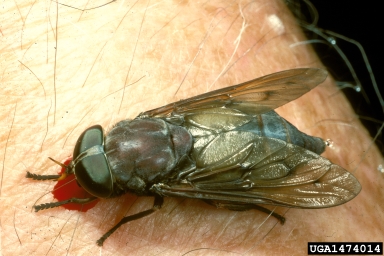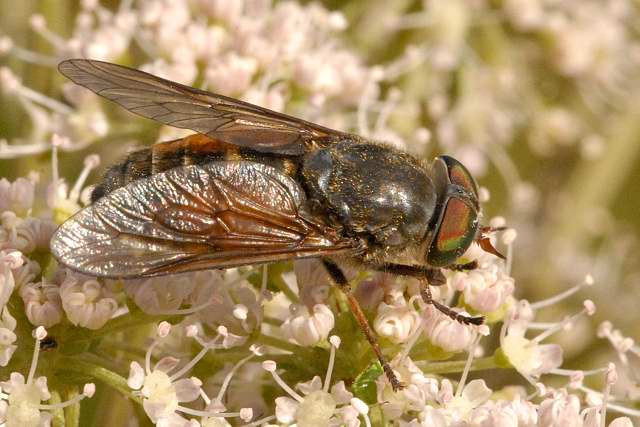
Nutrition
Tabanus
longiglossus is known for the painful bites that it and other
horsefly species inflict.
Fascinatingly, only the females inflict these bites while the
males feed on the nectar and occasionally pollen of flowers.
The females require meals of blood in order for them to
reproduce. Females of
this species, as well as other species of horseflies, feed on
various vertebrates (Grimaldi
and Engel
2005). They
are most well known for feeding
 on mammals but they may feed on
birds, reptiles, or amphibians as well.
Sometimes they have attacked herds of dairy cattle so
viciously that they significantly reduce their milk yields (Resh
and Carde
2003). Most
people are familiar with the nuisance of their presence, leaving
painful, itchy bites that can result in substantial blood loss.
When in search of a blood meal the females land on a victim
just out of reach so they can’t be swatted away.
After they land they create a laceration on the host’s skin
on mammals but they may feed on
birds, reptiles, or amphibians as well.
Sometimes they have attacked herds of dairy cattle so
viciously that they significantly reduce their milk yields (Resh
and Carde
2003). Most
people are familiar with the nuisance of their presence, leaving
painful, itchy bites that can result in substantial blood loss.
When in search of a blood meal the females land on a victim
just out of reach so they can’t be swatted away.
After they land they create a laceration on the host’s skin
 with their serrated, blade-like mandibles and maxillae (this is why
their bites are so painful) as opposed to say, mosquitos that
puncture the skin of their host to retrieve blood.
Once the blood begins to pool either under or on the host’s
skin Tabanus longiglossus
goes to work soaking it up with their extended labella.
When they have retrieved all the blood they need they fly
away leaving a bloody wound (Grimaldi
and Engel
2005). If
the fly is infected with a disease a bite can pass it to the victim
(Resh
and Carde
2003). More information
on the diseases that Tabanus longiglossus you can go to the
interactions page of this website. As
mentioned previously, the males do not feed on blood and lack
mandibles, the mouthparts necessary to do so.
Due to the fact that they only frequent flowers they are
rarely seen (Arnett
1985). Once
their food is ingested it passes through a fully functioning gut
just as all other Arthropods.
The food is stored in the crop until it is passed through the
rest of the gut. They
also have an open circulatory system like other insects do (Hickman
2012).
with their serrated, blade-like mandibles and maxillae (this is why
their bites are so painful) as opposed to say, mosquitos that
puncture the skin of their host to retrieve blood.
Once the blood begins to pool either under or on the host’s
skin Tabanus longiglossus
goes to work soaking it up with their extended labella.
When they have retrieved all the blood they need they fly
away leaving a bloody wound (Grimaldi
and Engel
2005). If
the fly is infected with a disease a bite can pass it to the victim
(Resh
and Carde
2003). More information
on the diseases that Tabanus longiglossus you can go to the
interactions page of this website. As
mentioned previously, the males do not feed on blood and lack
mandibles, the mouthparts necessary to do so.
Due to the fact that they only frequent flowers they are
rarely seen (Arnett
1985). Once
their food is ingested it passes through a fully functioning gut
just as all other Arthropods.
The food is stored in the crop until it is passed through the
rest of the gut. They
also have an open circulatory system like other insects do (Hickman
2012).